Fifty years ago, someone wanting to avoid gluten had one choice: eating just plain meats, fish and produce. Twenty years ago, you may have been able to find a not-so-great version of pasta. Today, there’s a whole world of great - tasting gluten-free choices.
According to Mambo Sprouts, one-third of natural and organic consumers are looking for allergen-free foods, and 25% of those are interested in gluten-free items because of an intolerance or allergy (1).
Luckily for these folks, the natural products industry is responding with numerous great products that give those on a gluten-free diet a reason to dig in!
Gluten-Free: The Whys and Hows
Countless Americans are choosing to avoid gluten, the protein found in grains like most wheat varieties, rye, bran, barley and others. A main reason is the rise in diagnoses of celiac disease. Those with this autoimmune disease have an atypical response to gluten: the immune system damages the villi found in the small intestines. This causes gastrointestinal distress and problems like malnutrition (since the villi help absorb nutrients) and anemia (2).
Says Levon Kurkjian, vice president of marketing at Kettle Cuisine, Chelsea, MA, “For individuals living with celiac disease, a gluten-free diet is absolutely the only treatment and, therefore, they are definitely the top candidates for the diet.”
But, gluten-free food specialists make the point that you shouldn’t pigeon-hole your gluten-free section by assuming it’s only appropriate for those with celiac disease. In fact, there’s a much larger pool of consumers who may consider eating glutenfree foods, if a knowledgeable retailer can explain to them why.
Headaches and migraines. Some anecdotal reports indicate gluten may trigger headaches in certain individuals. Says jerry Bigam, president of Kinnikinnick Foods, Edmonton, AB, Canada, “They have reported to us that they have had the blood test for celiac disease and are negative, but have found through trial and error that a gluten free diet improves these conditions.”
 A recent study centered on 79 children that complained of frequent headaches and were not diagnosed with celiac disease. The group was put on a gluten-free diet, and 77% experienced fewer headaches. In the end, 5% of the children were diagnosed with celiac disease. They were so convinced of the gluten–headache connection that they stated patients with chronic headaches should be checked for celiac disease and possibly put on a gluten-free diet (3).
A recent study centered on 79 children that complained of frequent headaches and were not diagnosed with celiac disease. The group was put on a gluten-free diet, and 77% experienced fewer headaches. In the end, 5% of the children were diagnosed with celiac disease. They were so convinced of the gluten–headache connection that they stated patients with chronic headaches should be checked for celiac disease and possibly put on a gluten-free diet (3).
Diabetes. The American Diabetes Association believes there may be a link between type-1 diabetes and celiac disease. According to the group’s Web site, “About one in 20 people with type-1 diabetes has celiac disease.”
Skin problems. According to the American Osteopathic College of Dermatology, those with dermatitis herpetiformis (which causes an itchy, stinging rash) may want to consider going on a gluten-free diet (4). The group believes an allergy to gluten may cause this disease. When gluten and IgA (an antibody made in the intestines) circulate the bloodstream together, blood vessels can become blocked and a rash develops.
Autism. Anecdotal evidence supports the use of a glutenfree/ casein-free (GFCF) diet for children with autism who may have trouble processing peptides and proteins in gluten- and casein-containing foods. A recent study presented by Autism Speaks’ Autism Treatment network (ATn) showed that 17% of children enrolled in the ATn were on a special diet. Half of those only ate GFCF foods (5).
Other disorders. Again, though the scientific research is not mountainous, growing research points to the use of a gluten-free diet for those with digestive autoimmune diseases like ulcerative colitis and cro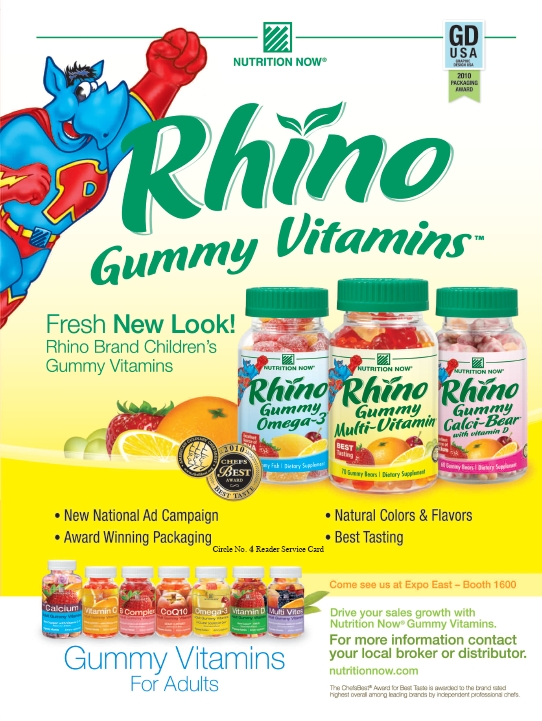 hn’s.
hn’s.
General population—not so fast...Retailers should dispel the inaccurate notion that a gluten-free diet is automatically a “healthier diet” for your average, healthy shopper, says Bigam. Though formulators are constantly improving on their product’s nutritional value, some gluten-free foods are lower in fiber, protein and other nutrients compared with their counterparts, he states.
Cynthia Kupper, R.D., executive director of the Gluten Intolerance Group of north America, Auburn WA, agrees, noting, “The gluten-free diet is not necessarily a healthy diet for the general population and if not handled well, can increase risks of nutritional deficiencies.” For instance, when wheat and other grains are removed from some gluten-free foods, a key source of vitamin B is also removed. Also, she says that the gluten-free diet can be naturally low in iron, calcium, magnesium, zinc and other vitamins and minerals.
If one’s balance of vitamins and minerals is monitored, Michael Smulders, founder and president of Bakery on Main, East Hartford, CT, notes that healthy individuals may feel a little extra spunk on a gluten-free diet. “Many people report feeling better and more energetic when they eat little or no wheat or other gluten containing grains. There is also a rapidly developing trend toward a gluten free diet in performance athletics,” he states.
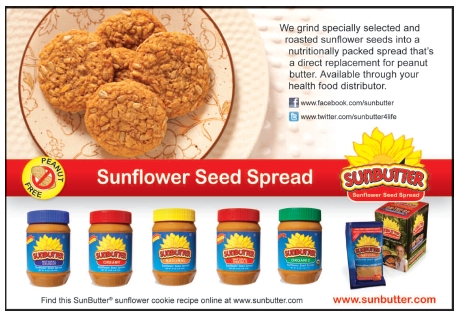 According to a press release from Bakery on Main, the Garmin- Transitions U.S. Cycling Team tried using a gluten-free diet during its multi-week races to reduce inflammation and improve performance. One cycler told Men’s Journal, “My performance really improved a lot—there was definitely a correlation. I think that my digestion is better, and because of that my sleep is better and my recovery is better.”
According to a press release from Bakery on Main, the Garmin- Transitions U.S. Cycling Team tried using a gluten-free diet during its multi-week races to reduce inflammation and improve performance. One cycler told Men’s Journal, “My performance really improved a lot—there was definitely a correlation. I think that my digestion is better, and because of that my sleep is better and my recovery is better.”
According to Bakery on Main, this group is the first to publicly use a gluten-free diet and say that it improved their athletic performance (6).
Innovations in the Gluten-Free Category
Consumer interest in gluten-free products has inspired companies to develop interesting and unique gluten-free products. “Gluten-free prepared foods always had the potential to taste great, but since the market opportunity was so small, as recently as 10 years ago, food companies did not make investments in the category. Most that did jump in were not heavily focused on quality,” Kurkjian states.
Today, companies are pioneering novel ways to create gluten workarounds in recipes. The result? “newer gluten-free formulas are much moister and have a better finished product consistency,” says Ray Martin, vice president of sales and marketing at Hodgson Mill, Effingham, IL.
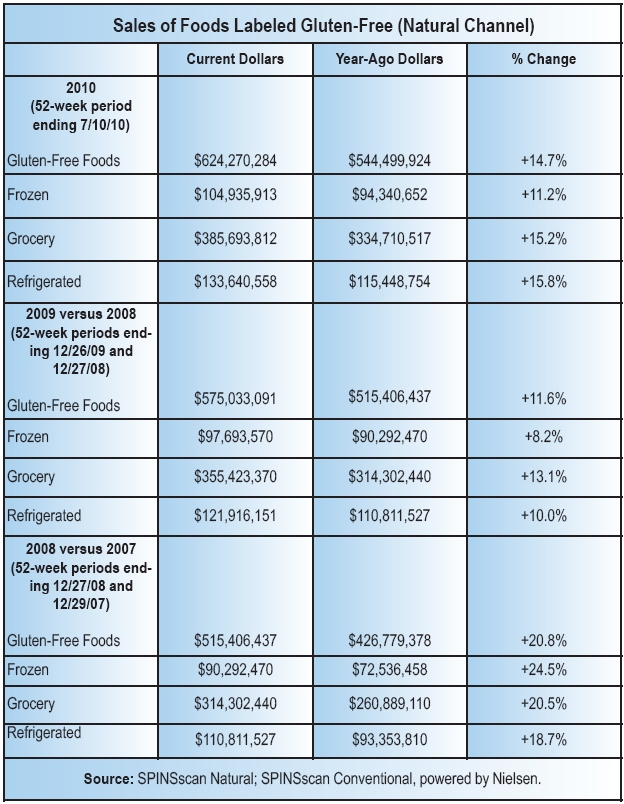 Boosting nutrition is an area that Kupper says is important. “The nutritional quality of many gluten-free products is lower than similar wheat-based products. More effort needs to be made to make gluten-free foods nutritionally superior since the gluten-free grains are generally lacking in some nutrients, as is the diet.” She notes that “nutritionally superior” gluten- free grains include quinoa, sorghum and amaranth, which may affect the flavor and text of some products.
Boosting nutrition is an area that Kupper says is important. “The nutritional quality of many gluten-free products is lower than similar wheat-based products. More effort needs to be made to make gluten-free foods nutritionally superior since the gluten-free grains are generally lacking in some nutrients, as is the diet.” She notes that “nutritionally superior” gluten- free grains include quinoa, sorghum and amaranth, which may affect the flavor and text of some products.
So, companies are going back to the recipe lab to find ways to make these ingredients work, Kupper explains, noting that firms are also fortifying and/or enriching their products with extra vitamins and minerals. “A gluten-free diet doesn’t mean we just need to replace carbs—it means we need to create a well-rounded diet that fits our nutritional needs,” she states.
Another potential problem is that gluten-free products are typically carbheavy and while some carbohydrates are healthy, others are not. Says David j. Fulton, marketing director and inventor for Yes! To Cookies, Austin, Tx, “My core philosophy was not to create a gluten-free food, but rather to remove all grain, starch, flour and sweeteners that digest to glucose. By removing these ingredients, I also managed to remove gluten.” He states that some sweeteners used in gluten-free baked foods may contribute to poorly managed blood glucose, gastric discomfort and other health problems.
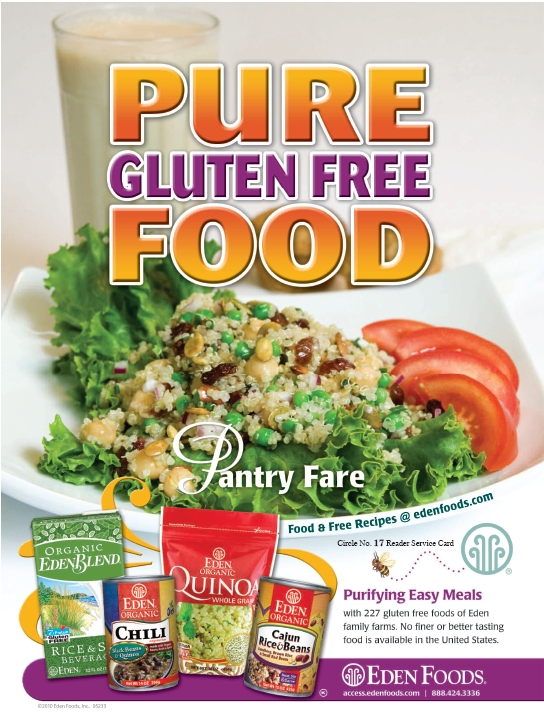 One example is potato flour, which Fulton says has a glycemic index of 120. This faster-acting carbohydrate (often used to replace wheat flour in gluten-free foods) may be fine for certain individuals. But, it will likely be problematic for diabetics trying to manage healthy blood glucose levels. Unfortunately, Fulton feels that most individuals (be they shoppers or health food store staff members) do not consider whether gluten was replaced with a highglycemic carbohydrate. “This is despite a significant portion of celiacs and diabetics that have both conditions,” Fulton states.
One example is potato flour, which Fulton says has a glycemic index of 120. This faster-acting carbohydrate (often used to replace wheat flour in gluten-free foods) may be fine for certain individuals. But, it will likely be problematic for diabetics trying to manage healthy blood glucose levels. Unfortunately, Fulton feels that most individuals (be they shoppers or health food store staff members) do not consider whether gluten was replaced with a highglycemic carbohydrate. “This is despite a significant portion of celiacs and diabetics that have both conditions,” Fulton states.
For this reason, Fulton’s company “replaced starch and sugar with fiber that the body does not have the enzymes to digest,” states Fulton.
Smulders agrees that making nutritious gluten-free products is an important development in the gluten-free category, also noting that fiber is important. “High-fiber food for celiac disease patients is an important trend because it can be hard for them to get enough fiber in their diet,” he states, noting that to answer this need, his firm has created fiber-boosted products such as Bakery On Main’s Fiber Power gluten-free granola.
Robyn Milewski, CEO of Pure nRG, Pure SKIn, feels that having good sources of protein are important, too. Her firm’s high-protein bars “are very high in protein (we use pea and hemp) and also sunflower seed butter, which is an amazing butter offering nutrition, elasticity, flavor and the ability to blend well with our flavor profiles. We’re also adding tea and coffee to our bars for a extra kick and rich flavor (mocha java, vanilla chai and chocolate).”
One raw material company that is helping to innovate the category of healthy, gluten-free foods, Martin says, is Con Agra, which is “putting a great deal of research into developing gluten-free flours that perform extremely well.” For instance, the firm’s Eagle Mills gluten-free all-purpose multigrain flour blends ancient grains and tapioca flour to help give gluten-free foods whole-grain nutrition and fiber as well as a good appearance, texture and flavor.
 Texture and flavor are always on the minds of gluten-free sweets makers like Pamela’s Products, says Stephanie Robbins, director of marketing for the Ukiah, CA-based company. She says her company focuses on foods that “taste great and offer a texture and mouth feel that offers enjoyment… When Pamela set out on this journey in 1988, this was not the way that gluten-free foods were created by other companies. She wanted to create foods that everyone could enjoy together.”
Texture and flavor are always on the minds of gluten-free sweets makers like Pamela’s Products, says Stephanie Robbins, director of marketing for the Ukiah, CA-based company. She says her company focuses on foods that “taste great and offer a texture and mouth feel that offers enjoyment… When Pamela set out on this journey in 1988, this was not the way that gluten-free foods were created by other companies. She wanted to create foods that everyone could enjoy together.”
In agreement is Martin, who states, “Consumers are looking for taste as they always do. Historically, gluten-free products have been referred to as dry, cardboard like and crumbly. Consumers want products that they can feel proud to prepare for the whole family regardless of whether or not they have Celiac disease.”
Nancy Cain, owner of Against The Grain Gourmet, Brattleboro, vT, believes some innovations in the gluten-free category are going too far outside the boundaries of “natural” in an effort to improve texture. “Springiness and lengthened shelf life are not coming from artisan baking secrets, but rather from industrialized food ingredients” like some baking enzymes she states. While this technology may help bread remain soft for nearly two weeks, Cain says that genetic engineering is used to make them. “This is not a positive development,” she feels. If you or your customers are concerned about this issue, check with your finished product manufacturer for more information about how their products are made.
Cain says she prefers tapioca as a primary starch. “Tapioca holds water and bends when frozen and thawed,” she feels.
Last, according to Robbins, companies are making strides in making convenient products for gluten-free shoppers. “Those living gluten-free have the same needs for convenience as anyone else,” she states, noting that her company offers singleserve Baking & Pancake Mix and Chocolate Brownie Mix. “These are also wonderful for travelers, college students and afternoon snacks. They also provide portion control!” she exclaims.
Advances in gluten-free convenience foods and home meal replacements may have a significant impact on this category. Says Bigam, “These bring a new level of complexity to gluten-free manufacturers, but this will be a strengthening trend.”
Where do we go from here? Growth in the gluten-free foods category is far from over. Industry companies say there are several areas where we may see additional evolution. “In a recent survey,” says Kurkjian, “we found that only 15% of gluten-free consumers are pleased with the variety of options available to them and only 21% are pleased with the taste and quality of prepared food products that they have purchased. As such, it is our opinion that they are not as much looking for anything new, rather, better and more options of what is already available.”
How exactly can the category improve and grow? According to those interviewed for this piece, keep your eyes on these areas of the gluten-free market:
• Pastries, baked goods, mixes,
• Expanded cereals, particularly corn-free, gluten-free items,
• Snack foods,
• Meal replacements/convenience foods,
• Pasta.
Regardless of how many products may be coming down the gluten-free pike, Bigam reminds us to be sure the products meet gluten-free standards. “Consumers need to be assured that any of these items meet the necessary food safety standard (of 20 ppm or lower),” he states.
Groups like the Gluten-Free Certification Organization certify that products do not contain gluten or other allergens. visit www.gfco.org/products.php for a list of products that meet their standards and carry the Certified GF seal.
Become a Gluten-Free Magnet
Independent retailers have been major players in gluten-free food sales, and gluten-free products are big money makers for many retailers. But now, some mainstream companies like General Mills are capitalizing on the gluten-free trend. With traditional grocery stores now carrying numerous gluten-free options, how can independent retailers stay in the game?
“The emerging trend of conventional retailers developing gluten-free sections will have a direct impact on sales and perhaps even more important profit margins,” states Bigam. But, he makes an important point: a main strength of 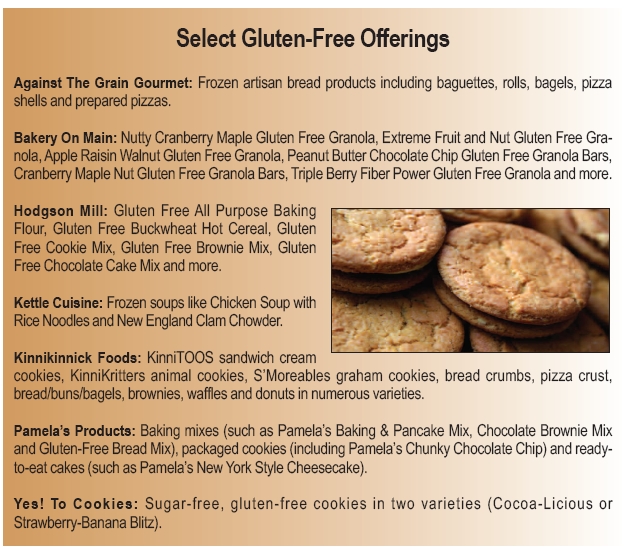 specialty retailers that traditional stores cannot match is customer service.
specialty retailers that traditional stores cannot match is customer service.
Bigam notes that while traditional companies may carry certain popular products, independents may be able to carry broader lines and regional specialties.
Robbins also comments on how small stores can use inventory to their advantage. “They usually have a closer connection to their customers,” she states. “With that connection, retailers should find what their customers are looking to purchase. There are no hard and fast rules on this, except that connecting with your loyal consumers is a good plan.”
Overall, Smulders says independents shouldn’t be afraid to invest in a wellplanned gluten-free section. “Being a leader in gluten-free foods is a great opportunity for independent retailers who make their stores a destination for gluten-free shoppers. Mainstream markets typically have four- to eight-foot sections of glutenfree foods. Celiacs need more selection and will happily shop in a smaller store that offers a greater selection and unique new items.” This is especially true of the glutenfree category, since traditional grocers won’t be able to stock new items as quickly.
 Adds Milewski, “Mainstream stores may not invest in the variety that consumers are looking for. [They] will tend to carry one or two lines at best and place them in small sections of the store. Many independents are making room for full sections of gluten-free and this will grow as well.”
Adds Milewski, “Mainstream stores may not invest in the variety that consumers are looking for. [They] will tend to carry one or two lines at best and place them in small sections of the store. Many independents are making room for full sections of gluten-free and this will grow as well.”
Cain believes that independent stores can be a “gluten-free magnet” if the staff truly understands the gluten-free market and its shoppers. “They go to these retailers for an array of gluten-free product options (and not necessarily the cheapest ones), and because these stores have created a ‘gluten-free community’ with education, honest product reviews, gluten-free samplings, support groups, and special gluten-free events.”
Consider some of these ideas from interviewees for making your store a magnet for gluten-free buyers:
• Carry a variety of products.
•Alert local interest groups (celiac, autism and others) about your offerings.
• Stock other allergen-free items.
•Hold a gluten-free sampling fair.
•Hand out flyers about how to follow a gluten-free diet.
•Hand out gluten-free recipes.
•Mark your gluten-free section with proper signage.
•Ask vendors to help with promotions. WF
References 1. M. Saline, “Allergy-free Foods need More Space,” Mambo Sprouts, May 24, 2010.
2. E.M. Ward, “Gluten Intolerance: Against the Grain,” www.webmd.com/digestive-disorders/ celiac-disease/features/gluten-intolerance-againstgrain, accessed August 24, 2010.
3. E. Lionetti, “Headache in Pediatric Patients with Celiac Disease and its Prevalence as a Diagnostic Clue,” J. Pediatr. Gastroenterol. Nutr. 49 (2), 202–207 (2009).
4. American Osteopathic College of Dermatology, “Dermatologic Disease Database,”www. aocd.org/skin/dermatologic_diseases/dermatitis_ herpeti.html, accessed Aug. 25, 2010.
5. American Academy of Pediatrics, “Treatment Plan for Children With Autism Often Includes Complementary Therapies,” press release distributed May 2, 2010.
6. Bakery on Main, “Pro Cyclists Include Bakery On Main Gluten Free Granola in Their Recipe for Success,” press release distributed July 16, 2010.
Published in WholeFoods Magazine, October 2010,










